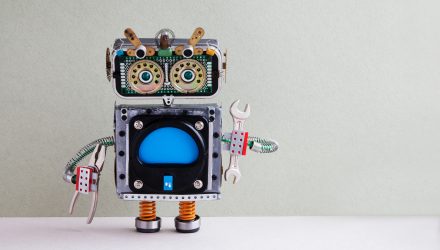So if, for instance, the robot is programmed to go in a given direction, but then it encounters an obstacle in its path, the force sensor will sense an abnormal force vector and will stop. This technique is used by companies that transform their industrial robots into collaborative robots, such as the well-known Fanuc (CR-35iA) and Comau (AURA).
The goal of fitting an industrial robot on a sensor and under a soft skin is to allow to the manufacturer to re-use well-established robots and introduce cobots to companies that are already using their robot. If you’re already using 95 Fanuc robots in your automotive plant, you’d probably prefer to continue using the same programming method and the same hardware, rather than learn a new cobot programming software.
The other advantage of this technology is that you can have a large robot with a large payload and still very good sensitivity to force (impact). These robots can typically handle payloads of up to 35 kg, and will still react to small impacts.
However, you will need to set the payload correctly so that the robot can compute whether the force applied at the force sensor is higher than the set weight that the robot is supposed to handle. This means that Force Sensor Base robots are a bit more complicated to use than the Joint Sensing type – but they are also more precise and safer for the user.
Skin sensing
This type of force limited robot is not as widespread in the industry, but it’s probably the safest option out there. Robots like the BOSCH (APAS) use tactile sensing (of all kinds) to detect impact. The sensor monitors the conductivity of the robot’s body, and instructs the robot to stop once it reaches a certain threshold.
I think this type of robot seems like a really complex solution for the manufacturer, but a really safe solution for the end-user. Impacts are kept to a minimum, and sometimes the robot can even stop before it hits something, which is pretty impressive.
Inherently safe
Inherently safe robots may use any (or all) types of sensors. What distinguishes them is that they cannot hurt you – in any way.
As you may have noticed, a robot with a 35 kg payload could still hurt you if something goes wrong. Inherently safe robots, on the other hand, are simply too weak to do much damage.
Take the ABB (YUMI) with its 0.5 kg payload, for example. The upside of its low payload is that it’s practically unable to hurt you. Although you still need to set the robot in order to prevent injuries, there are very few ways to injure yourself with this type of robot.
Final thoughts
Throughout the text, I’ve pointed out robots that are great examples of what’s being done in the industry. At the same time, though, there are a lot more cobots out there.
Keep in mind that all collaborative robots should be safety-rated and/or approved by a third party. Hopefully this will help guide you towards the right choice for your next robot!
